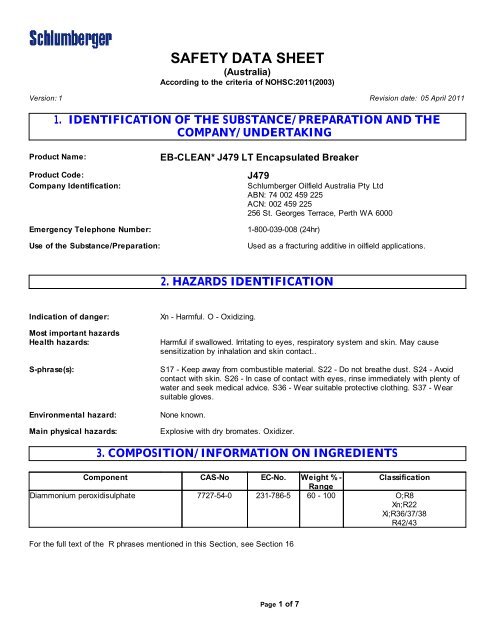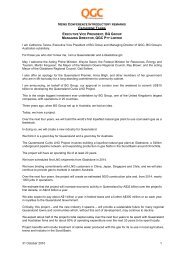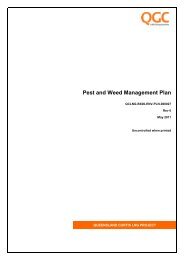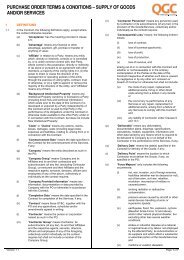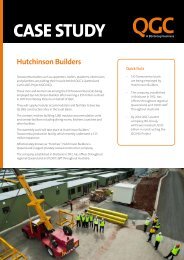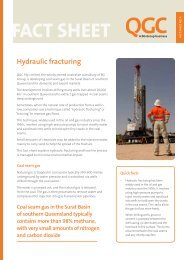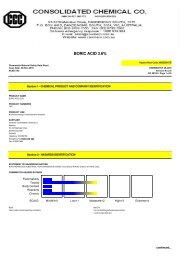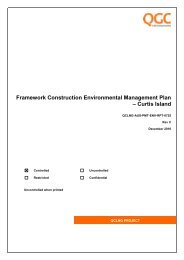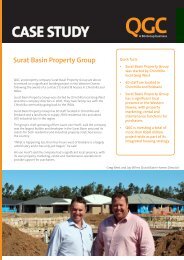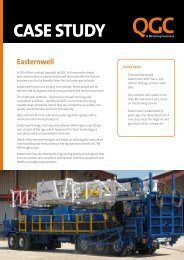SAFETY DATA SHEET - Santos
SAFETY DATA SHEET - Santos
SAFETY DATA SHEET - Santos
Create successful ePaper yourself
Turn your PDF publications into a flip-book with our unique Google optimized e-Paper software.
<strong>SAFETY</strong> <strong>DATA</strong> <strong>SHEET</strong>(Australia)According to the criteria of NOHSC:2011(2003)Version: 1Revision date: 05 April 20111. IDENTIFICATION OF THE SUBSTANCE/PREPARATION AND THECOMPANY/UNDERTAKINGProduct Name:Product Code:Company Identification:Emergency Telephone Number:EB-CLEAN* J479 LT Encapsulated BreakerJ479Schlumberger Oilfield Australia Pty LtdABN: 74 002 459 225ACN: 002 459 225256 St. Georges Terrace, Perth WA 60001-800-039-008 (24hr)Use of the Substance/Preparation:Used as a fracturing additive in oilfield applications.2. HAZARDS IDENTIFICATIONIndication of danger:Most important hazardsHealth hazards:S-phrase(s):Environmental hazard:Main physical hazards:Xn - Harmful. O - Oxidizing.Harmful if swallowed. Irritating to eyes, respiratory system and skin. May causesensitization by inhalation and skin contact..S17 - Keep away from combustible material. S22 - Do not breathe dust. S24 - Avoidcontact with skin. S26 - In case of contact with eyes, rinse immediately with plenty ofwater and seek medical advice. S36 - Wear suitable protective clothing. S37 - Wearsuitable gloves.None known.Explosive with dry bromates. Oxidizer.3. COMPOSITION/INFORMATION ON INGREDIENTSComponent CAS-No EC-No. Weight % - ClassificationRangeDiammonium peroxidisulphate 7727-54-0 231-786-5 60 - 100 O;R8Xn;R22Xi;R36/37/38R42/43For the full text of the R phrases mentioned in this Section, see Section 16Page 1 of 7
Version: 1/AUSLProduct Code: J479________________________________________________________________________________________4. FIRST AID MEASURESInhalation:Skin contact:Eye contact:Ingestion:Move to fresh air. Consult a physician if necessary.Take off contaminated clothing and shoes immediately. Wash off immediately withsoap and plenty of water. Seek medical attention if irritation occurs.Immediately flush eyes with water for 15 minutes while holding eyelids open. Seekmedical attention.Do NOT induce vomiting. Drink large quantities of milk (preferred) or water. Consult aphysician if necessary.5. FIRE-FIGHTING MEASURESSuitable extinguishing media:Extinguishing media which must not be used for safetyreasons:Deluge with water. Other methods not effective.None known.Special protective equipment for firefighters:Wear protective fire fighting clothing and avoid breathingvapors. Use self-contained breathing apparatus in closedareas.Special exposure hazards arising from the substance orpreparation itself, its combustion products, or releasedgases:Oxygen. Hydrogen chloride. When heated strongly or burned,oxides of carbon and harmful organic chemical fumes arereleased. Explosive with dry bromates.6. ACCIDENTAL RELEASE MEASURESPersonal precautions:Environmental precautions:Methods for cleaning up:Do not get on skin or clothing. Wash thoroughly afterhandling.Prevent further leakage or spillage.Sweep up and shovel into suitable containers for disposal.7. HANDLING AND STORAGEHandling:Technical measures/Precautions:Safe handling advice:Avoid dust formation.Provide appropriate exhaust ventilation at places where dust isformed.Storage:Technical measures/Storage conditions:Do not store, transport with or allow to contact dry bromates.Store in well ventilated area out of direct sunlight. Keepcontainers tightly closed in a dry, cool and well-ventilatedplace.Page 2 of 7
Version: 1/AUSLProduct Code: J479________________________________________________________________________________________Packaging requirements:Incompatible products:Bag with moisture barrier.Do not store, transport with or allow to contact combustiblematerials, corrosives, reducing agents or dry bromates8. EXPOSURE CONTROLS / PERSONAL PROTECTIONEngineering measures toreduce exposure:Ensure adequate ventilationRespiratory protection: Half mask with a particle filter P2 (BS EN 143).Hand protection:Eye protection:Skin and body protection:Rubber gloves. Impervious gloves made of: PVCTightly fitting safety goggles.Clean, body-covering clothing.Environmental exposure controlsExposure limit(s)ComponentAustralia - Occupational Exposure Standards Australia - Occupational Exposure- TWAsStandards - STELsDiammonium peroxidisulphate None None9. PHYSICAL AND CHEMICAL PROPERTIESGeneral InformationForm:Odour:Colour:Granulesmild SweetWhiteImportant Health, Safety and Environmental InformationpH: 6.5 - 8pH concentration:@ 10 g/lBoiling point/range:DecomposesFlash point:Not applicable.Explosive properties:Explosion data - sensitivity to mechanical impact: None knownExplosion data - sensitivity to static discharge: None knownFlammability Limits in Air:lower:Not applicableupper:Not applicableOxidizing properties:OxidizerRelative density:1.8 (@ 20°C)Bulk density:1150 kg/m3Solubility:Water solubility:10 - 20 g/l (@ 20°C)Fat solubility:Insoluble.Page 3 of 7
Version: 1/AUSLProduct Code: J479________________________________________________________________________________________Partition coefficient(n-octanol/water):Viscosity:Vapour density:Vapour pressure:Evaporation rate:Not applicable.Not applicable.Not applicable.Not applicable.Not applicable.Other informationMelting point/range:Decomposes10. STABILITY AND REACTIVITYStability:Conditions to avoid:Materials to avoid:Hazardous decompositionproducts:Hazardous polymerization:May release hydrogen chloride above 120 F (49 C).Decomposes with heat.Organics, Dry bromates, Combustible material, Reducing agentsOxygen. Hydrogen chloride. When heated strongly or burned, oxides of carbon andharmful organic chemical fumes are released. Sulfur oxides. nitrogen oxides (NOx).Explosive with dry bromates.Hazardous polymerization does not occur.11. TOXICOLOGICAL INFORMATIONLocal effectsSkin:Eyes:Inhalation:Ingestion:Sensitization - skin:Irritant; may cause pain, redness, dermatitis.Irritant. May cause pain, redness, discomfort.Irritant; may cause pain and coughing.Harmful if swallowed; large amounts may cause illness. Irritant; may cause pain ordiscomfort to mouth, throat and stomach.May cause sensitization by skin contact.Sensitization - lung:Chronic Health HazardCarcinogenic effects:Mutagenic effects:Teratogenic effects:Reproductive toxicity:Target organ effects:None known.Not known to cause heritable genetic damage.Not known to cause birth defects or have a deleterious effect on a developing fetus.Not known to adversely affect reproductive functions and organs.None known.Page 4 of 7
Version: 1/AUSLProduct Code: J479________________________________________________________________________________________12. ECOLOGICAL INFORMATIONEcotoxicityCOMPONENT INFORMATIONDiammonium peroxidisulphateBioaccumulation:Persistence and degradability:Crustacean toxicity:Freshwater Fish Species DataWater Flea DataNot applicableNot applicable48h LC50= 21 mg/l (Acartia tonsa)LC50 96 h (Lepomis macrochirus) = 103 mg/LLC50 96 h (Oncorhynchus mykiss) = 76.3 mg/LLC50 96 h (Poecilia reticulata) = 323 mg/LEC50 48 h (Daphnia magna) = 120 mg/L13. DISPOSAL CONSIDERATIONSWaste from residues / unusedproducts:Contaminated packaging:Dispose of as special waste in compliance with local and national regulationsSend empty bags to sanitary landfill. Render other types of containers unuseable bypuncturing or crushing and sanitary landfill unless prohibited by local regulations14. TRANSPORT INFORMATIONUN number: UN 1444Shipping name:AMMONIUM PERSULPHATE MixtureADR/RIDClass: 5.1Classification Code: O2Packing Group:IIIADR/RID-Labels 5.1Hazard ID 50IMDG/IMOClass or Div.:5.1Label(s): 5.1Packing Group:IIIEmS:F-A, S-QICAO/IATAClass or Div.: 5.1Label(s): 5.1Packing group:IIIPacking instruction 559(passenger aircraft):Packing instruction 563(cargo aircraft):Max Net Qty/Pkg: 25 kgMax Net Qty/Pkg: 100 kgPage 5 of 7
Version: 1/AUSLProduct Code: J479________________________________________________________________________________________15. REGULATORY INFORMATIONIn accordance with the criteria of NOHSCcontains: Diammonium peroxidisulphate.Indication of danger:Xn - HarmfulO - OxidizingR-phrase(s):R 8 - Contact with combustible material may cause fire.R22 - Harmful if swallowed.R36/37/38 - Irritating to eyes, respiratory system and skin.R42/43 - May cause sensitization by inhalation and skin contact.S-phrase(s):S17 - Keep away from combustible material.S22 - Do not breathe dust.S24 - Avoid contact with skin.S26 - In case of contact with eyes, rinse immediately with plenty of water and seek medical advice.S36 - Wear suitable protective clothing.S37 - Wear suitable gloves.International InventoriesAustralia (AICS):All the constituents of this material are listed on the Australian Inventory of ChemicalSubstances (AICS).16. OTHER INFORMATIONText of R phrases mentioned in Section 3R 8 - Contact with combustible material may cause fire.R22 - Harmful if swallowed.R42/43 - May cause sensitization by inhalation and skin contact.R36/37/38 - Irritating to eyes, respiratory system and skin.Prepared by:Chemical Regulatory ComplianceThe information and recommendations contained herein are based upon tests believed to be reliable. However,Schlumberger does not guarantee their accuracy or completeness NOR SHALL ANY OF THIS INFORMATION CONSTITUTEA WARRANTY, WHETHER EXPRESSED OR IMPLIED, AS TO THE <strong>SAFETY</strong> OF THE GOODS, THE MERCHANTABILITYOF THE GOODS, OR THE FITNESS OF THE GOODS FOR A PARTICULAR PURPOSE. Adjustment to conform to actualconditions of usage may be required. Schlumberger assumes no responsibility for results obtained or for incidental orconsequential damages, including lost profits arising from the use of these data. No warranty against infringement of anypatent, copyright or trademark is made or implied.End of Safety Data SheetPage 6 of 7
Version: 1/AUSLProduct Code: J479________________________________________________________________________________________Page 7 of 7


